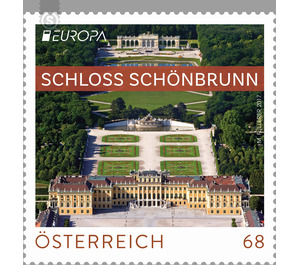Europe - Austria / II. Republic of Austria 2017 - 68 Euro Cent
Theme: Architecture
| Country | Austria / II. Republic of Austria |
| Issue Date | 2017 |
| Face Value | 68.00 |
| Edition Issued | 230,000 |
| Perforation | 14¼ x 13¾ |
| Printing Type | offset |
| Stamp Type | Commemorative |
| Item Type | Stamp |
| Chronological Issue Number | 2677 |
| Chronological Chapter | OOS-OE2 |
| SID | 920157 |
| Dimensions | 42.00 x 42.00 |
| In 77 Wishlists | |
The Association of European Postal Companies PostEurop chose the topic "locks" for this year's EUROPA stamp. The Austrian edition shows the largest and most famous castle in the country, Schönbrunn Palace in Vienna. The estate on which today stands the castle, was formerly referred to as "Katterburg". In 1569 it came into the possession of the Habsburgs and was used as a hunting ground and for the breeding of game. The widow of Emperor Ferdinand II, Eleonora of Gonzaga, had a pleasure palace built on the grounds around 1642, which for the first time bore the name Schönbrunn - according to a source that Kaiser Matthias describes as the "Beautiful Fountain". After the destruction of the castle in the course of the Turkish siege, Emperor Leopold I commissioned the architect Johann Bernhard Fischer von Erlach in 1693 with the construction of a representative hunting lodge for his son Joseph I. The building was built in a strictly symmetrical manner, in the style of a baroque palace Obelisks at the entrance, a large outside staircase and a spacious garden. Maria Theresa, who founded the castle in 1740 as a gift from her father Charles VI. Finally, the castle became her regular summer residence and under the direction of the architect Nikolaus Pacassi had it extensively rebuilt and extended. Under her also the castle park was designed with the Gloriette, the Neptune fountain, the Roman ruins, avenues, fountains and sculptures. With Emperor Franz Joseph I. Schoenbrunn Palace experienced another glittering epoch. He was born there, spent most of his life there, and died there at the age of 86. Today the castle with the castle park is the most visited destination in Austria for tourists from home and abroad. Splendid rooms such as the Great Gallery, the Porcelain Room or the Rococo-style Hall of Mirrors can be visited as well as the former sleeping and working rooms of the imperial family. Since 1996, the Schönbrunn Palace with its gardens as a Baroque Gesamtkunstwerk has been a UNESCO World Heritage Site. The brand image shows the castle and the park with the Neptune Fountain and the Gloriette bird's eye view.


